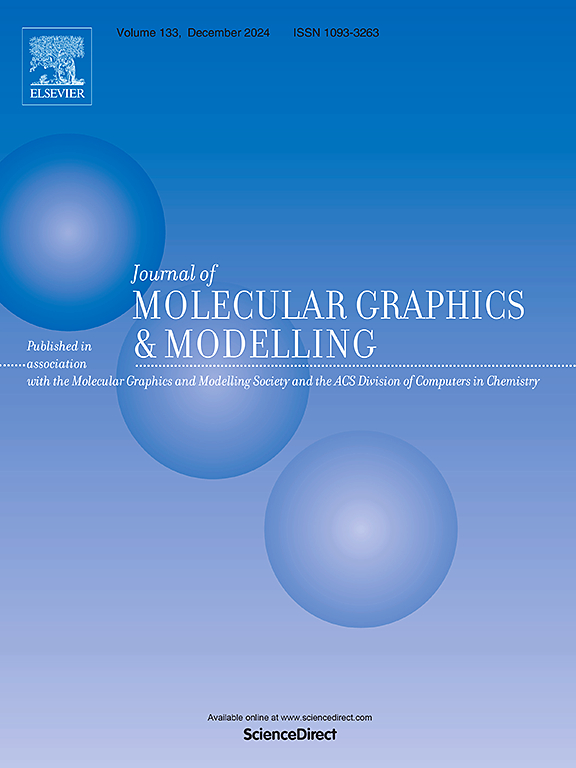越简单越好?用从头算、DFT、基团可加性和半经验近似计算短链氯化石蜡的生成焓和熵
IF 3
4区 生物学
Q2 BIOCHEMICAL RESEARCH METHODS
引用次数: 0
摘要
采用基于自动反应的方法,结合DLPNO-CCSD(T)/CBS计算,推导了32种含有10-13个C原子和3-11个Cl原子的短链氯化石蜡(SCCPs)的生成焓(ΔfH0)。在修正和缩放的刚性转子-谐振子(msRRHO)近似框架下,采用B3LYP-D3(BJ)/def2-TZVP优化几何形状和振动频率获得了绝对熵(S)。利用CREST程序和GFNn-xTB/FF方法估计了熵的构象修正。对快速半经验方法性能的检验表明,它们适合于分子熵的快速评估(平均无号偏差MUDRM1 = 2.3 cal mol−1 K−1),而只有PM6方法再现参考文献ΔfH0, MUDPM6 = 2.4 kcal mol−1,大致在估计的平均误差范围内(2.8 kcal mol−1)。相比之下,简单的Benson群可加法(GA)在MUDGA = 0.8 kcal mol−1时得到ΔfH0值,但在MUDGA = 20.4 cal mol−1 K−1时,明显高估了熵。获得的可靠的ΔfH0和S值数据集可用于进一步开发具有丰富构象景观的中型分子的快速有效的气相热化学评价方法。本文章由计算机程序翻译,如有差异,请以英文原文为准。

The simpler the better? Enthalpies of formation and entropies of short-chain chlorinated paraffins by ab initio, DFT, group additivity and semiempirical approximations
An automated reaction-based approach coupled with DLPNO-CCSD(T)/CBS calculations was used to derive enthalpies of formation (ΔfH0) of 32 short-chain chlorinated paraffins (SCCPs) containing 10–13 C atoms and 3–11 Cl atoms. Absolute entropies (S) were obtained using B3LYP-D3(BJ)/def2-TZVP optimized geometries and vibrational frequencies in the framework of the modified and scaled rigid rotor – harmonic oscillator (msRRHO) approximation. Conformational corrections to entropies were estimated using the CREST program and GFNn-xTB/FF methods. Examination of the performance of fast semiempirical methods reveals them to be suitable for the express evaluation of molecular entropies (mean unsigned deviation MUDRM1 = 2.3 cal mol−1 K−1), while only PM6 method reproduces reference ΔfH0 with MUDPM6 = 2.4 kcal mol−1, approximately within the estimated average error limits (2.8 kcal mol−1). In contrast, simple Benson's group additivity method (GA) yields ΔfH0 values with MUDGA = 0.8 kcal mol−1 but turns out to significantly overestimate entropies with MUDGA = 20.4 cal mol−1 K−1. The obtained datasets of reliable ΔfH0 and S values can be used for the further development of fast and efficient methods for the gas-phase thermochemistry evaluations of medium-sized molecules with rich conformational landscapes.
求助全文
通过发布文献求助,成功后即可免费获取论文全文。
去求助
来源期刊

Journal of molecular graphics & modelling
生物-计算机:跨学科应用
CiteScore
5.50
自引率
6.90%
发文量
216
审稿时长
35 days
期刊介绍:
The Journal of Molecular Graphics and Modelling is devoted to the publication of papers on the uses of computers in theoretical investigations of molecular structure, function, interaction, and design. The scope of the journal includes all aspects of molecular modeling and computational chemistry, including, for instance, the study of molecular shape and properties, molecular simulations, protein and polymer engineering, drug design, materials design, structure-activity and structure-property relationships, database mining, and compound library design.
As a primary research journal, JMGM seeks to bring new knowledge to the attention of our readers. As such, submissions to the journal need to not only report results, but must draw conclusions and explore implications of the work presented. Authors are strongly encouraged to bear this in mind when preparing manuscripts. Routine applications of standard modelling approaches, providing only very limited new scientific insight, will not meet our criteria for publication. Reproducibility of reported calculations is an important issue. Wherever possible, we urge authors to enhance their papers with Supplementary Data, for example, in QSAR studies machine-readable versions of molecular datasets or in the development of new force-field parameters versions of the topology and force field parameter files. Routine applications of existing methods that do not lead to genuinely new insight will not be considered.
 求助内容:
求助内容: 应助结果提醒方式:
应助结果提醒方式:


